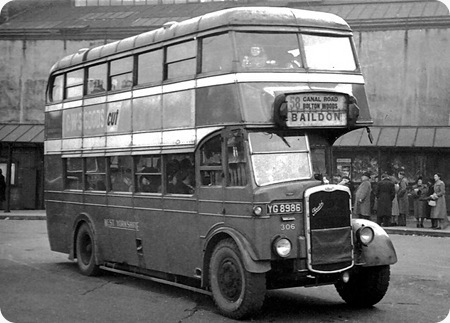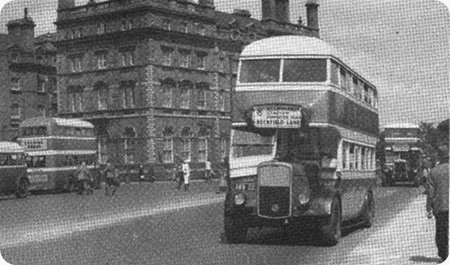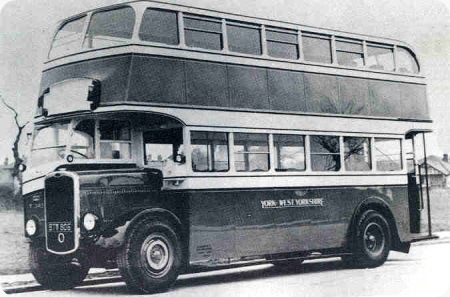
Copyright Roy Marshall
West Yorkshire Road Car Company
1935
Bristol GO5G
Eastern Counties L53R
West Yorkshire Bristol GO5G 306 with Eastern Counties L53R body built in 1935 is seen at Bradford
Chester Street Bus Station about 1950. It is ready to depart to Baildon via Canal Road and this
information is clearly displayed on its “bible” indicator. For its return journey, the conductor or
driver would release the side clips on the ‘bible” to enable the horizontal flap to be turned to show
“Bradford.” The intermediate destination points in reverse order would also be revealed on the hidden
“page” after which the ‘bible” was then re-clipped.
No doubt the crews welcomed the adoption by
West Yorkshire of roller indicator blinds from 1944 onwards, though the operating handles were still
outside and involved a clamber over a hot radiator but there was no more awkward lifting of a heavy
“bible” metal sheet arrangement. I wonder what injuries occurred and whether there were any compensation
claims with handling of the “bible” indicator metal sheets.
306 was withdrawn from service at the
end of November 1950 but the “bible” indicators remained in use with West Yorkshire I believe in 1958
with the demise of the last pre-war Bristol L5Gs.
Can anybody confirm the date of the last pre-war
L5Gs? I have only West Yorkshire fleet lists to 1955.
Photograph and Copy contributed by Richard Fieldhouse
———
27/02/11 - 08:39
Thank you Richard for sharing with us this wonderfully composed and evocative
picture. I have departed from that very spot countless times when I worked for West Yorkshire at
Ilkley Depot. We operated services 63/68 to Ilkley and Ben Rhydding via Manningham Lane or Canal
Road, and had just one weekday trip to Baildon - out via route 59 and Baildon Road and return via
route 61 and Baildon Green. I never had to use the incredible and ludicrous "bible"
indicators and, quite rightly, they would never have been permitted in today’s Health and Safety
climate - this legislation is often sneered at, and can be "over the top" on occasion but
it was certainly sorely needed in those days. At a quick glance it would appear that the last prewar
L5Gs were indeed withdrawn in September 1958. Of interest is the "Tilling Group" swivel
radiator filler cap, retro fitted to most vehicles in place of the original flat screw down pattern.
Thanks once again for a particularly splendid picture.
Chris Youhill
———
27/02/11 - 11:19
I know I am susceptible to nostalgia, buses being no exception, but this photo
has it all for me! As a child, I remember the shape of the ECOC "G" bodies so well, as
they contrasted vividly with the post war fleet. They lasted until 1952, as they had provided cover
for the company’s "K" type rebodying programme.
I can see them now, hurtling down
Thornton Road from Denholm, leaving clouds of smoke in their wake.
What a place Chester Street
was for a young enthusiast. Day trips to Baildon and Ilkley on such delights as 306, and their
"J" cousins, and stopping off at Harry Ramsdens on the way back. Most of all, awareness of
contrasting shape variations amongst the WY fleet. There was that green hut, full of stacks of spare
bible indicators, and, as you exited the bus station, at the little parking area to the right, bus
backs of differing profiles would persuade you of the delights of BOVRIL, or else pose the question,
"Have you McLeaned your teeth today"?
Wonderful memories of a superb fleet in its
heyday!
Can it be 60 years since the passing of these fine vehicles?
Thanks to Richard
for this post…. Any more WYRC Co. enthusiasts out there?
John Whitaker
———
27/02/11 - 11:25
Yes, a lovely picture with much nostalgic value. I didn’t realise that
‘bible’ indicators were still in use as late as 1958 - they lasted until 1955 in York, where I
never heard them referred to by any of the older staff as anything other than ‘flap boards’.
West Yorkshire must have been very fond of them because they actually converted some of the vehicles
they inherited from York Corporation to bibles from blinds.
The picture indicates, and I
assume from Richard’s description, that the hinge was horizontal and that the flap was raised or
lowered. That’s how I remember them, but I have seen photos, (pre-war), clearly showing a vertical
hinge where the flap was turned like a page in a book. Can anyone throw any light on this?
In
addition to being heavy and awkward, a problem with ‘bible’ indicators arose when the vehicle
operated on more than one route. It would then be necessary to carry another board, either under the
staircase or, on a single-decker, lodged between the bonnet and nearside mudguard. York’s Circle
route, with three different destinations, would require a change of board every hour; some
photographs suggest an additional slip board, just showing the change in intermediate route points,
but I really can’t be sure about that; however the problem was solved, it would have been a tiresome
bind for the crews, no doubt.
Thank you again, Richard, for this great picture.
Roy Burke
———
27/02/11 - 16:10
A question for Chris, then…
How did you get a 5G like this one up
Browgate into Baildon? With great difficulty?
I remember the ‘flap boards"on York
buses: they gave the York fleet a wonderfully old-fashioned & "foreign" look that went
with the rest of the place- and the white boards went with the white "lavatory brick" so
often seen in York (sorry- "Yark”)!
Joe
———
27/02/11 - 20:03
Roy you are quite right - although in the minority there were versions of
these boards where the hinge was vertical and the pages turned "book fashion" - I remember
them well and they were around after the War also. Additionally there were other lightweight boards
with only one narrow line carrying the ultimate destination in black and the route number in red.
They were shaped like a letter "H", with slender legs at either side and the narrow route
line midway between bottom and top - these must have been far easier to "hoist aloft" than
the full size multi-leaf monstrosities.
Joe, you’ll have the Gardner legal team after you!!
Slow steady progress in low gears was essential of course, but the big hearted Gardners would go
anywhere you know - however Browgate did admittedly often demand first gear. I have a wonderful
piece of video which I took on an enthusiasts’ outing on preserved KDG 26. Knowing what was to come
I positioned myself on the nearside front seat and the superb and highly competent driver chose just
the right moment to execute a masterly change into first gear without the slightest jerk or click. I
often wonder to this day how the GO5Gs and similar models managed to achieve Leeds to Harrogate in
virtually the same running time as the present day despite having to tackle the ascent to Moortown,
Harewood Bank and Almsford Bank and so forth.
Chris Youhill
———
28/02/11 - 06:45
Eastern Counties were also users of bible indicators although whether they
lasted into the fifties I couldn’t say.
Lancs United had their own variant on the bible this
was the slot in stencil which was a metal stencil which was back lit. The boards were dropped into
the indicator box by the conductor. On double deckers the boards were kept under the stairs and
would occasionally fall over with a great clatter.
Preserved LUT Leyland Tiger 114 CTF 423 a
1938 TS7 with Roe bodywork has had the feature restored and can be seen in its restored glory at this link.
Chris Hough
———
02/03/11
Strange how Eastern Counties produced a rather nice five bay body on this and
then changed to a six bay design on later construction, as on the North Western K5G’s
Chris Barker
———
02/03/11
In 1934 Keighley-West Yorkshire took delivery of two Bristol G-types - K111/2
(YG 5733/4) - which were the first Bristols to be fitted with Gardner’s new 5LW diesel engine.
Previous G-types had been powered by Bristol’s own design of 6-cylinder petrol engine, and indeed
the chassis of K111/2 were originally to have been powered by this unit. However they were modified
to take the Gardner engines during construction at Bristol, and were subsequently given chassis
numbers GO5G.1 and GO5G.2, denoting G-type, Oil engine, 5-cylinder, Gardner. The vehicles were of
further historic interest as they were West Yorkshire’s first Bristols and also the first Bristols
to be fitted with lowbridge bodywork (in this case 52-seaters by Brush).
Further GO5Gs were
delivered to WY in 1935 (including the imposingly handsome 306 in the photo), these as mentioned
having ECOC bodywork - the forerunners of what would become Eastern Coach Works. Thus started WY’s
long and happy relationship with the hallowed trinity of Bristol chassis, Gardner engine and ECW
bodywork that lasted into the ‘Bristol’ Olympian era - only thwarted when Leyland
short-sightedly closed the Bristol factory in 1983.
Regarding Joe’s comment on the progress of
5Gs up into Baildon, I well remember a WY fitter commenting that they might have been plodders but
they were unbelievably reliable and very economical. His quote was that "they might be slow but
they could pull‘t town hall down on a pint o’ diesel!" He may have had a point!
Brendan Smith
———
03/03/11 - 08:39
I can certainly vouch for Brendan`s comment about the pulling power of WYRC
5LW engined buses. I well remember hearing each cylinder in its separate firing as a G mounted
Baildon Brow. They could have gone up a house side without stalling! I have similar memories of 5LW
West Yorkshire buses on Garrowby, and Hollins Hills!
The AWW batch of 1935 was less common in
Bradford, but their reversion to a 6 bay layout was more a return to norm, with the 5 bay batch
being very much an exception in ECOC output, a position which continued for the rest of Lowestoft’s
pre war production. Strangely enough, photographs of the AWW batch seem to be difficult to find.
John Whitaker
———
12/04/11 - 05:00
Referring to Chris Hough’s comments dated 28/02/2011, from 1945 to 1950/1 we
used to have our annual holiday at Lowestoft and we stayed at a house at the back of the town. The
road was part of the Eastern Counties route to Oulton Broad and my recollection is the buses had
"Bible Board" indicators. They were not as elaborate as the one in the photo but had a
pair of what looked like standard side lights to illuminate the boards in the dark. So it seems they
did last until then. Incidentally, the Eastern Counties coachworks were just down the road from the
boarding house and, periodically, chassis/engine units were delivered to the works from the
manufacturer and they were just that, just a chassis, engine, transmission and wheels (no
mudguards). They were driven to the works by a man sat upon a box tied to the chassis and wrapped in
multiple overcoats and scarves even in the height of summer! I assume they wore goggles because
there was no protection of any sort and it must have been grim in rainy or winter weather. The
Health and Safety people would have a major fit if that happened today
Phil Jones
———
19/04/11 - 19:14
Several sources quote West Yorkshire, and Eastern Counties as being the only
users of the so called "bible" indicator. There were detail differences between the
"bibles" of the 2 operators, principally with regard to the illuminating "side
lights" as used by ECOC. Of all the (superb) Tilling Group (or Ex Tilling after 1948)
companies, ECOC was, perhaps the most typical. Flat terrain enabled the extensive use of 4LW as well
as Gardner "5"s, and vehicle life was maximised. All in all, it was a fascinating fleet,
and one which I, as a West Yorkshire fan, would love to read more about!
John Whitaker
———
11/03/12 - 07:54
The Ipswich Transport Museum has 4 (unrestored) ECOC/ ECW bodied saloons all
ex ECOC. (1 x ADC, 1 x TS B9A, 1 x L5G, 1 x Dennis Ace) A collection of Ipswich area ‘tin
bibles’ is on display in the museum………
Eric M
———
11/03/12 - 09:00
Nearly a year later I have just read Phil J’s memories of the bare chassis
arriving at ECW from Bristol Commercial Vehicles. Seeing those brave men drive off from the Works in
a convoy of 5/6 at a time was a regular sight when I was young and riding my three wheeler bike to
wait by the Works entrance to see them set off.
Exactly as Phil says, there was no protection
of any kind except a canvas sheet in front of the pedals and that bare box to sit on..gosh it must
have been horrible to travel so far..about 160/170 miles on A/B roads back then and on a writhing,
floppy chassis with springs set up to take the body weight. They did indeed wear goggles and most
wore "Herbert Johnson" motorcycle crash helmets and a scarf over the mouth to combat
flies.
On a cold Winter’s day it must have been absolute misery for them. Those big overcoats
were always a golden fawn colour..until the front got plastered in dirt and oil when they became
"two tone" in a rather unusual way!
Richard Leaman



